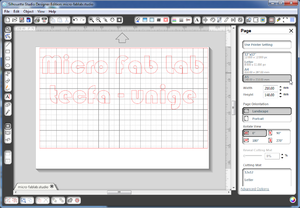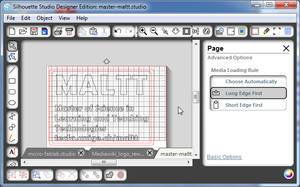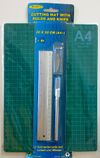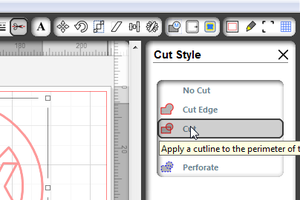Silhouette Cameo: Difference between revisions
m (using an external editor) |
m (using an external editor) |
||
| Line 150: | Line 150: | ||
=== Before === | === Before === | ||
[[image:cameo-svg1.png|thumb|300px|right|Prepare SVG]] | |||
Before importing an SVG image it is best to adapt it with your favorite vector graphics editor, e.g. Inkscape, Adobe Illustrator or Corel Draw | Before importing an SVG image it is best to adapt it with your favorite vector graphics editor, e.g. Inkscape, Adobe Illustrator or Corel Draw | ||
| Line 158: | Line 160: | ||
=== In the Studio Designer === | === In the Studio Designer === | ||
* {{quotation|As SVG files may contain multiple lines, some of which are intended for printing rather than cutting, to enable the desired cut lines you may go to the Cut Style menu (the icon that looks like scissors cutting a red line) and select the desired cut line style for your imported SVG image.}} ([https://www.silhouetteamerica.com/faq.aspx?solutionid=939 Opening SVG files (Designer Edition)], retrieved | * {{quotation|As SVG files may contain multiple lines, some of which are intended for printing rather than cutting, to enable the desired cut lines you may go to the Cut Style menu (the icon that looks like scissors cutting a red line) and select the desired cut line style for your imported SVG image.}} ([https://www.silhouetteamerica.com/faq.aspx?solutionid=939 Opening SVG files (Designer Edition)], retrieved 19:25, 14 February 2012 (CET)) | ||
* Select all drawings or each image individually then either define cut lines just for the outline or for all lines. | * Select all drawings or each image individually then either define cut lines just for the outline or for all lines. | ||
Revision as of 20:25, 14 February 2012
<pageby nominor="false" comments="false"/>
Introduction
The Silhouette CAMEO is a low cost home-user plotting/cutting machine. It's probably the most simple tool to get to start a simple fab lab.
This tool was the forth addition to the micro fab lab at TECFA.
According to Silhouette Cameo USA “The Silhouette CAMEO™ is an electronic cutting tool for personal use. Like a home printer, it plugs into your PC or Mac® with a simple USB cable. However, instead of printing it uses a small blade to cut paper, cardstock, vinyl, fabric and more up to 12" wide and 10 feet long. The machine also boasts a quiet motor and the ability to register and cut printed materials.”
Specifications and installation
What can it do ?
This machine can make Scrapbook pages, Cards, Custom apparel, Vinyl décor, Etched glass, Sketch designs, Temporary tattoos, Paper crafts. Technically speaking it can cut:
- Paper and cardstock
- Adhesive vinyl
- Fabric
- Heat transfer material
- Rhinestone templates
- Specialty media
A free software is included. The $50 extended Cameo software can read SVG files
Installation
- Download the latest software from http://silhouetteamerica.com/software. (This software also comes with the included CD, but it's an older version probably).
- Enter the 13 digit code if you also bought the Silhouette Studio Designer edition. This will unlock extra features
- Connect the Silhouette to your PC
- On Win 7 64-bit: Power off the Silhouette. Insert the CD in the box and install the driver which can be found on Silhouette-Studio/Driver_64_English/GDSETUP64.exe. Ignore the warnings in the installation dialog.
Vinyl cutting basics
The process includes the following major steps
- Designing
- Adjusting size (design and or "paper")
- Cutting
- Peeling off the unwanted stuff
- Applying to a surface (usually using transfer paper)
Creating a design with the Silhouette Studio Designer software, and then cutting it with the Silhouette Cameo is really easy.
However, we suggest not to start with a lot of lettering, since these are more difficult to transfer. A connected design is easer....
Create or load a design
These operations are done in the Silhouette Studio software.
Adjust page size:
- In page panel to the right, select the size of your drawing. You can use some presets, E.g. A5 landscape.
- You can ajust the size of the drawing panel at all time. Just make sure that the design fits and that you don't waste materials.
- If this panel doesn't show, click on the upper 4th icon on top from the right.
Create a design
- For starters, we suggest typing some text, but not too much (peeling off the vinyl is not so easy)
- You can select font, font-size and font variation in the Text Style panel (A icon on top
- Then, enter the text using the text tool A icon in the left tools panel.
- Readjust font size, etc. and position.
Verify settings
- I suggest to verify the page size again. Length doesn't matter, but width must be smaller than your vinyl roll's width.
- Also, make sure that you selected the right material (see also below)
Extra tips:
- Watch out for the "printing" edge. If you use a larger size (e.g. A4) the edge that feeds into the cutter may be wrong (i.e. the small edge, which is a waste on 12inch paper. Use advance Options (bottom of the panel) to fix that. E.g. select
- Long edge first
- Select 12x12 cutting mat (if it doesn't work). Then in the paper panel, deselect cutting mat again.
Select the cut settings
In the software:
- Open the silhouette cut settings panel (3rd icon from top/right)
- Select material, e.g. Silhouette Vinyl.
- This will adjust the speed and thickness.
- It will tell how to adjust the blade setting (see below)
- It also will tell if you need a cutting mat
Cut
On the Cameo:
Notice:
- No cutting of the vinyl is needed
- Just insert the roll. If you plan to cut it before, make sure that there is some extra space with respect to the design, i.e. at least 3cm else the rollers can't move the vinyl forwards and backwards ....
- Rolls may not be a suitable way to deliver vinyl. Since the vinyl will curb inwards/downwards on the cutter, the loading procedure can fail. Re-roll the vinylto the other side in order to remove some tension...
Procedure:
- Adjust the blade setting, e.g. 1 for vinyl (read p. 9 in the getting started manual)
- Adjust the rolles to the width of the material
- Release the blue lever on the right hand side
- Adjust the white roller that is on the right. Before moving it, hold the one on the left so that the bar can't turn. Then turn the right one so that it snaps off and then move it.
- Return the blue lever on the right hand side to upright lock position
- Insert the vinyl
- Insert the vinyl color side up. Make sure to push it to the left and that it fits under the white rollers.
- Select load media and press enter
- Adjust (straighten). Release the lever doing so and then close it again.
You are now ready to send the file for cutting ...
On the PC
- Click the Send to Silhouette button on the top toolbar.
- Verify the settings
- Click on (5) Cut page
Apply
- Cut the design (if not done before) off the roll.
- We suggest using a knife and a cutting map. You can buy one of these in any DoItYourself store.
Remove excess vinyl:
- Remove all the negative (not used vinyl).
- Hold down the stuff you want to keep by pressing with a finger or an other soft item such as the rubber end of a pencil. Peeling off the not wanted stuff isn't as easy as in the videos ...
- Use a hook (available in the starter kit) to remove small parts if necessary.
Apply transfer paper to design:
Instead of directly pulling off the vinyl and applying it to a surface it's better to use transfer paper. Transfer paper has light glue on one side and to which the vinyl will stick. There seem to be two variants: a cheaper tape-like roll and a more expensive roll with paper to peel off.
- Cut a transfer paper sheet in roughly the same size (else you will have to apply each item manually and that can go wrong)
- Remove the cover
- Apply it starting carefully from one end. It's best to apply it without any rotation. This way aligning the design to a surface will be easier.
- Smoothen it with the scraper (available in the Vinyl starter kit). Make sure to apply some force so that it is flat and that it sticks. If your design includes many little parts, make sure to apply pressure to each one !
- Then lift off the design. It should stick to the transfer paper
Apply the design to a surface
- Draw two points for alignment or find another procedure
- Stick it slowly starting from one end (You won't have many attempts)
- Then smoothen/apply with the scraper. Apply force and do it repetitively in both direction. Make sure to do it for each little part.
- Peel the transfer paper off
- Enjoy ....
SVG Import
After importing your first SVG file it just won't "print". "Cut page" will tell you that it was successful which is true since your imported graphic didn't have anything to cut. You will have to define cut lines and that is easy if your SVG graphic is simple.
Before
Before importing an SVG image it is best to adapt it with your favorite vector graphics editor, e.g. Inkscape, Adobe Illustrator or Corel Draw
- remove the fills of all areas
- add a stroke to each fill-only area
In the Studio Designer
- “As SVG files may contain multiple lines, some of which are intended for printing rather than cutting, to enable the desired cut lines you may go to the Cut Style menu (the icon that looks like scissors cutting a red line) and select the desired cut line style for your imported SVG image.” (Opening SVG files (Designer Edition), retrieved 19:25, 14 February 2012 (CET))
- Select all drawings or each image individually then either define cut lines just for the outline or for all lines.
- Typically you would use "cut" (second item, apply a cutline to the perimeter of the selected shape) in the Cut Style panel.
Links
Official
Reviews and ideas
- Silhouette CAMEO by by AshleyAnn.
- Silhouette Cameo Guide (Tips, Projects and more)
The Cameo and other vinyl cutters in Fab Labs
Sharable designs
- The 'Vinyl Cutter' System (Thingiverse). Includes a small list of things.
- OpenClipArt (you must own the SilhouetteStudio Designer Edition, $50).






